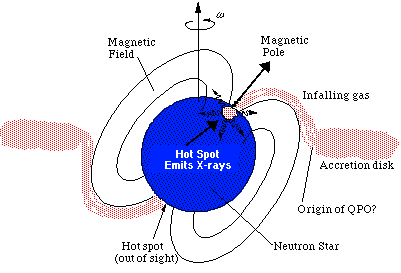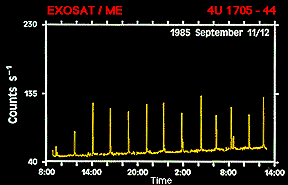Binary stars that pulse and flash

(Credit: H. Brandt, M. Halverson, and their students)
If the X-ray binary contains a neutron star, it may be seen to pulse in X-rays or give off bursts of X-rays. In the artist's impression seen here, the material is funneled by the strong magnetic field of the neutron star onto its magnetic poles. The magnetic fields on neutron stars can be as high as a trillion times that of the Earth. These are the strongest magnetic fields known anywhere in the universe, and X-ray astronomy is the only way to study them. Such strong magnetic fields cause the X-rays to appear "beamed", so that the X-ray pulsar appears as a "flashing lighthouse". In addition, the material falling in from the companion will hit a hard surface and this will shine in X-rays as an intense 'hot spot'. When X-ray observatories observe these systems, the hot spot near the magnetic pole will flash as the neutron star rotates. This is seen in the figure below.

Not all neutron star systems, however, have intense magnetic fields. It appears that in many of the low mass X-ray binary systems, the field is much weaker. In these cases, the flow of material onto the neutron star is more erratic, with the pulsations unstable. Many of these low magnetic field systems show what are called "quasi-periodic oscillations" (QPO). These oscillations seem to originate from the interaction of the neutron star with the surrounding accretion disk, or from instabilities in the captured material caused by the overwhelming intensity of the X-ray emission. Study of QPO in low mass binaries provides astronomers new insight into how the neutron star interacts with its surroundings.
Last Modified: January 2011


